In 1943, Bing Crosby sings “I’ll Be Home For Christmas.” Of course, for the men shown in the video, it was only in their dreams.

In 1943, Bing Crosby sings “I’ll Be Home For Christmas.” Of course, for the men shown in the video, it was only in their dreams.
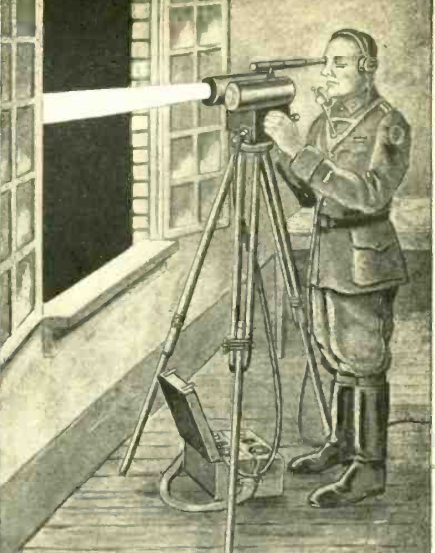 Seventy-five years ago this month, the December 1943 issue of Radio Craft included a description of this light-phone reportedly in use by the Germans.
Seventy-five years ago this month, the December 1943 issue of Radio Craft included a description of this light-phone reportedly in use by the Germans.
The set could operate in three modes: white light, red light, or infrared. Obviously, simple morse signalling was possible, but the beam could be modulated with audio.
The article noted that the applications of the device were rather limited, but wondered whether the Allies would be adopting a similar system at some point.
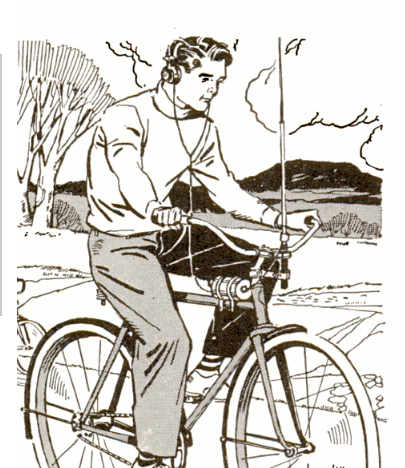 Just because there was a war going on didn’t mean that you couldn’t listen to the radio while riding your bicycle, as shown in Popular Mechanics. December 1943.
Just because there was a war going on didn’t mean that you couldn’t listen to the radio while riding your bicycle, as shown in Popular Mechanics. December 1943.
The set was billed as a “big town” bike receiver, and the article pointed out that it would pull in the local stations “as you ride around in any city where powerful stations are located.” The set itself was just a crystal set, using a fixed detector. The set was mounted in a tin can, which in turn was afixed to the bike. The tuning condenser and headphone connections were conveniently accessible while riding, and a whip antenna was used to pull in the strong local signals.
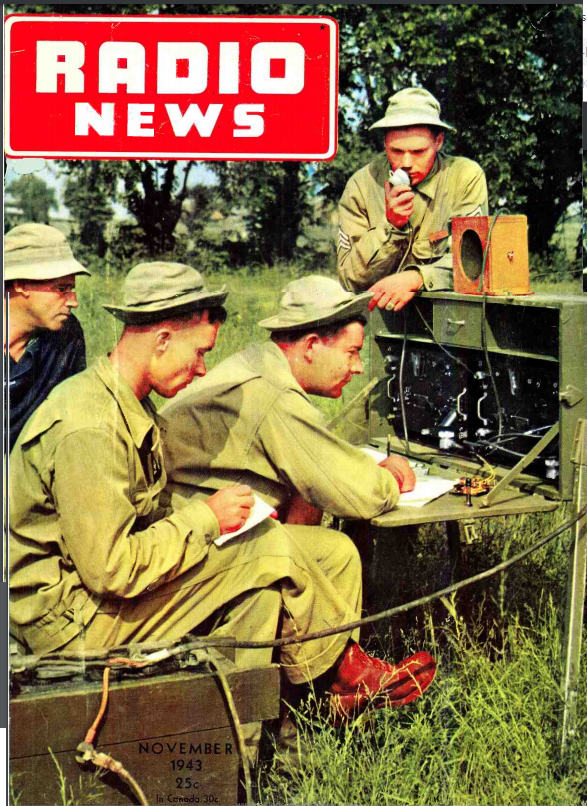 Unfortunately, the magazine doesn’t seem to provide any details as to what’s going on in this picture, from the cover of Radio News, November 1943.
Unfortunately, the magazine doesn’t seem to provide any details as to what’s going on in this picture, from the cover of Radio News, November 1943.
But obviously, these men are mastering the finer points of voice communication.

Wikipedia image. By Bundesarchiv, Bild 146-1970-083-42 / CC-BY-SA 3.0, CC BY-SA 3.0 de, Link
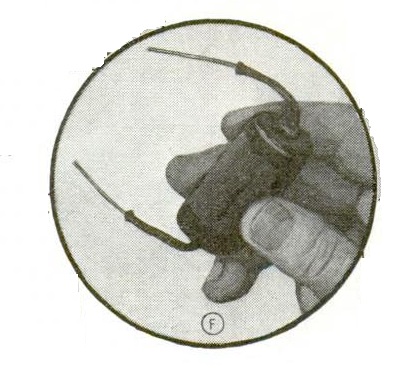 75 years ago, wartime shortages meant that meters were not readily available. The November 1943 issue of Popular Mechanics offers this tip for checking whether high voltage is present. A small capacitor (.25 to 2 uF, 400 volt) has spaghetti tubing placed over the leads, which are connected where the high voltage is being tested for. The capacitor is then removed and the ends shorted. A spark indicates the presence of high voltage.
75 years ago, wartime shortages meant that meters were not readily available. The November 1943 issue of Popular Mechanics offers this tip for checking whether high voltage is present. A small capacitor (.25 to 2 uF, 400 volt) has spaghetti tubing placed over the leads, which are connected where the high voltage is being tested for. The capacitor is then removed and the ends shorted. A spark indicates the presence of high voltage.
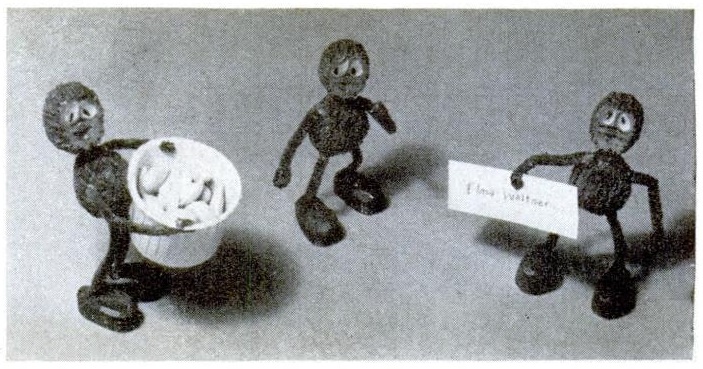 For Halloween this year, we offer this Halloween craft project from 75 years ago, courtesy of the November 1943 issue of Popular Science. Wartime shortages of Halloween decorations needn’t have put a damper on things, since you could just make these. They could be placed around the room for decorations, or serve as nut holders or place tag holders at the Halloween dinner table.
For Halloween this year, we offer this Halloween craft project from 75 years ago, courtesy of the November 1943 issue of Popular Science. Wartime shortages of Halloween decorations needn’t have put a damper on things, since you could just make these. They could be placed around the room for decorations, or serve as nut holders or place tag holders at the Halloween dinner table.
All that was needed were some walnuts, pipe cleaners, and a few miscellaneous bits that could be found around the shop. The main cuts were done with a coping saw, with the nut held in a vice. The magazine provided instructions on how to finish up the tiny goblins.
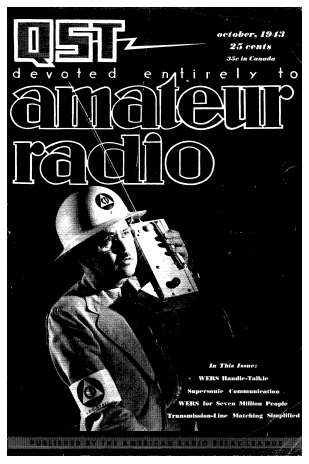 The cover of the October 1943 issue of QST showed the transceiver dubbed the “Handy Andy,” a two-tube handie talkie for use on the 112 MHz WERS band. The author notes that strictly speaking, the set is not a transceiver. Even though the same tube is used for both the transmitter and superregenerative receiver, different tank networks are used for each, allowing the frequencies to be adjusted separately. Switching was taken care of with a homemade switch, since both the audio and RF sections needed to be switched over.
The cover of the October 1943 issue of QST showed the transceiver dubbed the “Handy Andy,” a two-tube handie talkie for use on the 112 MHz WERS band. The author notes that strictly speaking, the set is not a transceiver. Even though the same tube is used for both the transmitter and superregenerative receiver, different tank networks are used for each, allowing the frequencies to be adjusted separately. Switching was taken care of with a homemade switch, since both the audio and RF sections needed to be switched over.
B batteries could be used, but the author noted that it was being used with a 130 volt vibrator power supply running from the car battery, which provided about 6.5 watts input power. Range was said to be between a quarter and half mile, which could possibly be extended with larger tubes and higher plate voltage. The RF section could use a 6J5, 6C5, 6F6, or 6V6GT. The audio tube could be a 6F6 or 6V6GT.
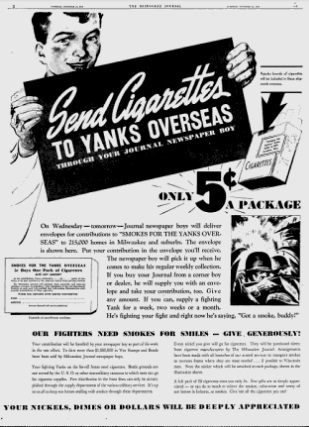 Seventy-five years ago today, the Milwaukee Journal and its subscribers were doing their part to win the war by sending cigarettes to the fighting men overseas. The October 19, 1943, issue of the paper carried this announcement that the following day’s paper would include an envelope taking up a collection. Readers were to put some money in the envelope, and give it to their paper boy along with the normal collection.
Seventy-five years ago today, the Milwaukee Journal and its subscribers were doing their part to win the war by sending cigarettes to the fighting men overseas. The October 19, 1943, issue of the paper carried this announcement that the following day’s paper would include an envelope taking up a collection. Readers were to put some money in the envelope, and give it to their paper boy along with the normal collection.
The newspaper would buy cigarettes for the fighting men at a nickel a pack, and send them overseas in cooperation with the War Department. A sticker on each pack would establish that the generosity of well-wishing Milwaukeeans made the gift of smokes possible.
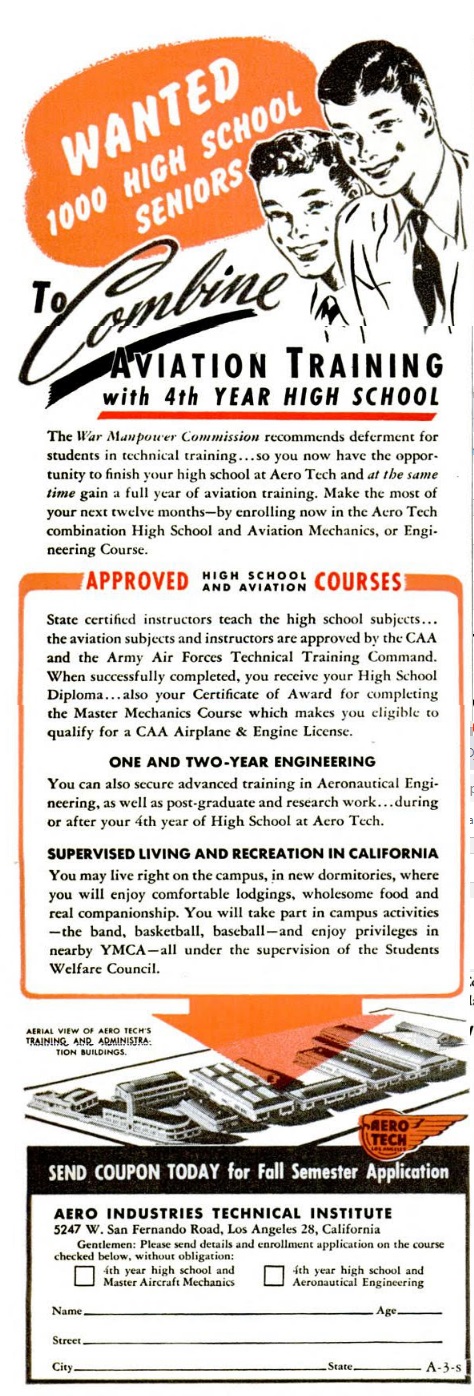 Seventy-five years ago, a technically inclined high school student might have given serious consideration to the proposal contained in this ad, which appeared in the October 1943 issue of Popular Science for the Aero Industries Technical Institute, 5247 W. San Fernando Road, Los Angeles,
Seventy-five years ago, a technically inclined high school student might have given serious consideration to the proposal contained in this ad, which appeared in the October 1943 issue of Popular Science for the Aero Industries Technical Institute, 5247 W. San Fernando Road, Los Angeles,
The ad starts out by reminding that students in technical training might be eligible for a draft deferment, and the school would give students a head start. They could complete their senior year of high school and at the same time gain a year of training in Aviation Mechanics or Engineering. High school courses were taught by state certified instructors, and the aviation instructors were approved by the CAA and military. Upon completion, the student would walk away with a California high school diploma and a certificate for completing the Master Mechanics Course.
Students lived in comfortable new dormitories where they would enjoy wholesome food and real companionship. Campus activities included a band, basketball, and baseball, and students had privileges at the nearby YMCA.
The location of the school today appears to be occupied by the International College of Beauty Arts & Sciences.